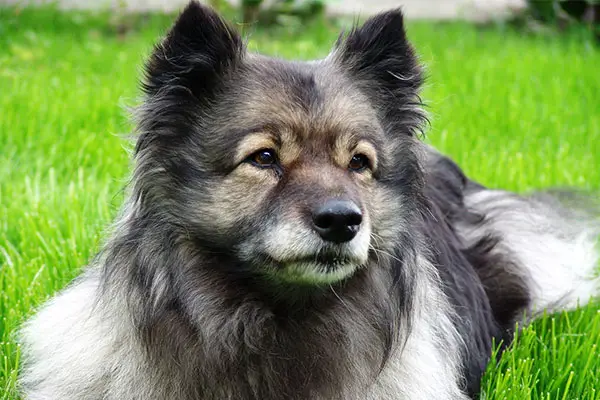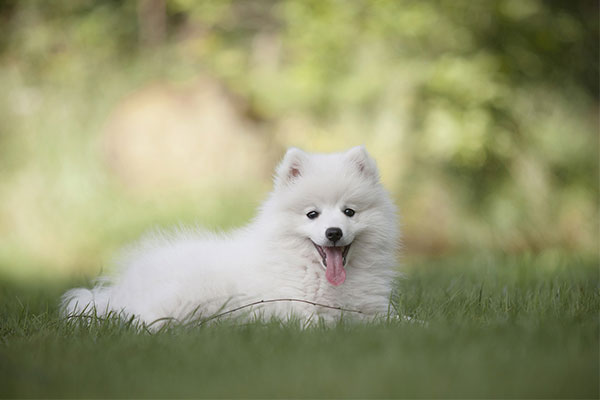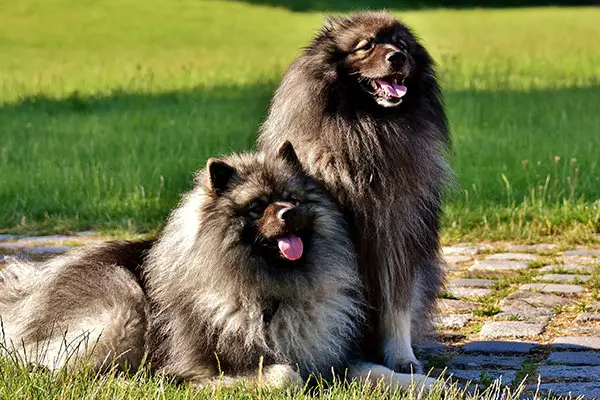Keeshond dogs are medium-sized dogs from an ancient line of dog breed. It is believed that the Keeshond has the same ancestors as the other spitz-type dogs. Like any other spitz, Kees feature a fox-like face, pointed ears, a furry coat, and a plumed tail.
These dogs are so friendly and people-oriented that it’s not best to put them inside a cage. They love being strut around, especially in show rings. These dogs make excellent pets, even for inexperienced dog owners.

Keeshond Breed Statistics
| Dog Breed Group | Non-Sporting |
| Breed Size | Medium |
| Height | 18 inches (male); 17 inches (female) |
| Weight | 35-45 pounds |
| Lifespan | 13-16 years |
Keeshond Breed Ratings
| Energy level | |
| Exercise needs | |
| Requires attention | |
| Playfulness | |
| Trainability | |
| Shedding | |
| Grooming | |
| Friendly with family | |
| Friendly with kids | |
| Friendly with strangers | |
| Friendly with other dogs | |
| Prey Drive |
Keeshond History
Keeshonden are ancient dogs that originated from Holland centuries ago. These dogs are usually on barges and farms, helping farmers control the vermin population by day. At night, they serve as excellent family companions.
Because they have existed in Holland for so long, they became a symbol of the Patriot Party in the 18th century. The leader of the Party was named Kees De Gyselear, and this is where the name of the breed came from.
However, when the group was overthrown, the Keeshond dogs were disfavored as the group’s representative. Many of these dogs were destroyed. Fortunately, a number survived on some farms and barges around Amsterdam.
By 1905, the breed was rediscovered by Fletcher. She was able to take home two puppies, which were then brought to England and later became the breed’s foundation.
The number of Keeshond in Holland continued to decline until 1920. And it took ten years before the breed’s number was increased and the Keeshond Club of England was formed.
In the year 1929, the first litter of Keeshonden was born in America, and by 1930, the breed was registered with the American Kennel Club. Five years later, The Keeshond Club of American was formed.
Now, the dogs rank 95th as the most popular dog breed in the US today. They are more companion dogs than hunting dogs, which makes them perfect for first-time dog owners.
Keeshond Temperament
Keeshonden are generally described as friendly, lively, and outgoing dogs. They crave human companionship, attention, and petting. You shouldn’t put these dogs inside cages as they need to be fully involved in the family.
Despite their small size, they will make excellent playmates for your children. But be sure to maintain supervision. They are also very friendly with other pets, so if you are not in the house, leave them with your other pets.
Though friendly, they will bark at strangers, but will immediately warm up once introduced. They make excellent watchdogs, but don’t expect them to guard. You can’t also expect them to do some working tasks.
They are straightforward to train but are also independent in some way. Make sure to be gentle and always provide positive reinforcements. Socialization is also important to make them more well-rounded.

Keeshond Care Requirements
- Nutrition: Keeshond dogs don’t have any special dietary requirements, but they need a high-quality and well-balanced diet to remain healthy and happy. Puppies might require more meals in a day than adults do. But, be careful in the number of calories you feed your Keeshonden in a day. They are easy to overfeed, so ask your vet for some advice. As for the food to feed him, there is no particular meal they like. Just make sure to take note of any allergies and stay away from those ingredients. Make sure to buy high-quality ingredients only that contain proteins, fats, carbohydrates, vitamins, and minerals. If you’re going to feed him dog food, make sure that you get the premium quality ones. Stay away from those that contain filler and additives, as this has very low nutritional content. At the same time, it can cause harm to your dog’s digestion.
- Grooming: Keeshonden have fluffy coats that shed seasonally. However, it requires regular grooming, at least 2-3 times a week. This will help keep the shedding at minimum, and ensure that no tangles or mats start forming. You can also take your dogs to a groomer and trim their coats around their feet and pads. This will help tidy it up and make them neater. You can also do this on your own, but make sure to be extra careful. Baths can be given once a month, but make sure to check and clean their ears regularly. Nails should be trimmed regularly as well. You don’t want long nails for your dogs, as this will cause pain and discomfort.
- Exercise: Keeshonden are great dogs that can adapt to many living environments. They are not particularly active and will do well in the comfort of your home. However, regular exercise is necessary to keep them healthy. Nothing high-impact is needed for these dogs. A nice daily walk or free run around the backyard will do. This can only be a few minutes in the day, and then they can go back to spending some time with you watching the television. What’s nice about the Keeshonden is that they are very happy dogs, and they’re content as long as you spend time with them.
- Health: Keeshonden are generally healthy dogs with a long lifespan. However, they, too, are prone to several diseases. They may not get this, but it’s still important to be aware of it. Bone diseases such as hip dysplasia and patellar luxation are common to the breed. They are also prone to eye diseases like progressive retinal atrophy and cataracts. Pay attention to what you feed them and what you put on their skin as they may get allergies too. Other diseases you should know about are Addison’s Disease, Diabetes Mellitus, Von Willebrand’s Disease, Hypothyroidism, and Epilepsy, which are all genetically transferred. It’s recommended to meet at least one of your dog’s parents to know what disease your dog might inherit. Screening tests are available for some health conditions too. It’s recommended to have your dog take one to rule out diseases at an earlier stage.
- Lifespan: The life expectancy of Keeshonds is 13-16 years.
Famous Keeshonden
- Saanie and Breda: First Keeshonden shown in a dog ring
Fun Facts about Keeshonden
- Keeshond is an ancient dog breed that originated from Holland.
- The name Keeshond came from Kees De Gyselear, the leader of the Patriot Party they represent.
- They almost became extinct in the 18th century when the Patriot Party was defeated; the enemy decided to get rid of some of the dogs.
- The plural form of Keeshond is Keeshonden.
- They are great watchdogs but not guard dogs.
- They are also called “the Smiling Dutchman” because of how their lips are when they open their mouths.
- They were recognized by the American Kennel Club in 1930.
Check Out Other Non-Sporting Dog Breeds:
American Eskimo Dog, Bichons Frises, Boston Terrier, Bulldog, Chinese Shar-Pei, Chow Chow, Coton de Tulear, Dalmatian, Finnish Spitz, Lhasa Apsos, Lowchen, Norwegian Lundehund, Schipperkes, Shiba Inu, Tibetan Spaniel, Tibetan Terrier, Xoloitzcuintli

